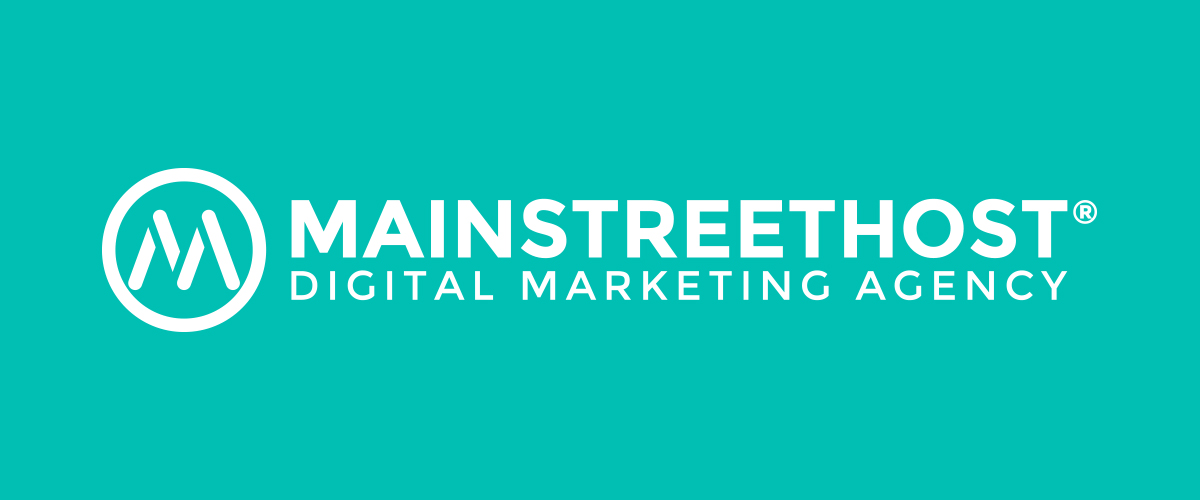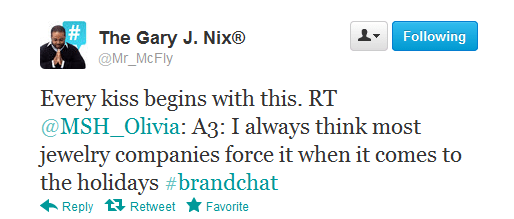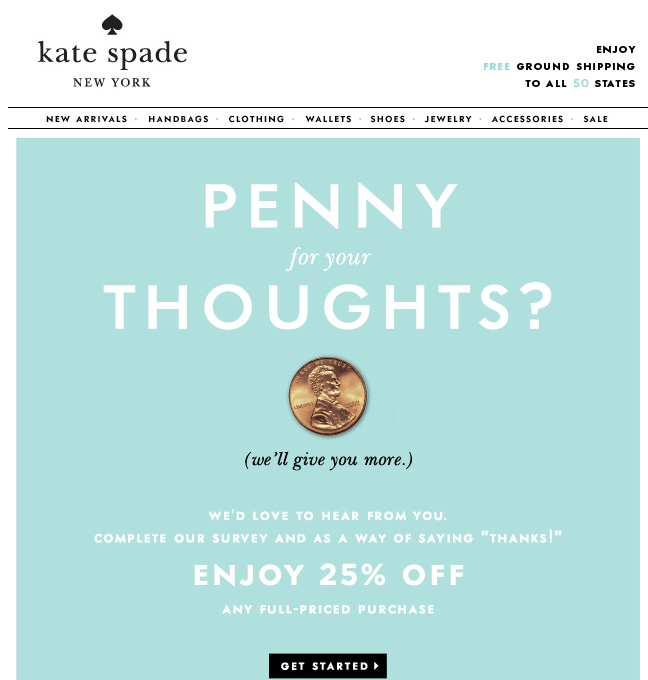Every Wednesday at 10am CT, Brand Chat hosts a Twitter chat, in which a plethora of marketing-minded individuals weigh in on a series of questions and engage in 140-character-capped conversations contemplative, pensive, astute, and witty alike. It’s an hour (more or less) of branding-related banter.
One of the questions posed by Brand Chat during last week’s Twitter chat stood out to me: “Holiday brands: which brands ‘get it’ and which brands ‘force it?'” I immediately thought of jewelry brands as businesses well-versed in artificiality, with those cliche, saccharine, cloyingly sentimental, and unrealistic holiday commercials (and it looks like the always-on-point Mr. McFly was on my wave length).
I thought this question about brands was intriguing, and while Brand Chat posed it in the context of the holidays, this question is applicable all year long. Here’s my list of brands that force it and brands that get it, along with what the hits and misses of these brands teach us about marketing, advertising, and the desires of everyday consumers.
Brands That Force It:
1. Starbucks
I’ll admit that I go to Starbucks at least twice a week, not because I’m a coffee cognoscente with discriminating tastes that can be satisfied only by Starbucks Pike roast, but rather because I simply can’t find a Pumpkin Spice Latte that tastes as good as the $4 and change one I guiltily buy there. The problem with Starbucks is this: its insistence on trying to give people a personalized experience. Whenever you order a drink at Starbucks, the employee asks you for your first name, which he or she writes on your cup. After you pay for your drink, the cashier tells you to “Have a nice day, [insert first name here].” When the barista finishes crafting your beverage, he or she calls out not your drink order, but rather your name. This first-name overload is an obvious marketing ploy, and Starbucks has good reason to try its hand at personalized marketing: people want relevant content, and providing people with such content is proven to be effective:
- Emails that use people’s first names have higher click-through rates.
- 80% of mobile internet users prefer ads relevant to them locally.
- 62% of adults under 34 are willing to share their location to get more relevant content.
- In a study of 650 multi-channel marketing campaigns, personalized campaigns consistently and overwhelmingly beat out static campaigns in generating a high response rate from recipients. (Source: HubSpot)
Clearly, people understandably prefer a customized, pertinent experience rather than a generic, nonspecific, irrelevant one. The problem is that Starbucks forces this kind of experience. I’ve written on this briefly before, but the whole business of asking for customer’s first names is fraught with complications. For one, Starbucks is notorious for spelling people’s names wrong; there are multiple Tumblr blogs devoted to ridiculous misspellings. Secondly, this artificial, simulated personalized experience doesn’t induce that warm and fuzzy feeling of going into your favorite local coffee shop and exchanging pleasantries with the small business owner. It’s a phony kind of familiarity, and perhaps it’s because this is a one-way exchange: I tell baristas my first name, but what am I really getting in exchange? Or perhaps it’s because when people say an individual’s name too much, it seems insincere.
Starbucks bills itself as a cozy, inviting, and congenial establishment (see: those iconic red holiday cups), but there’s a disconnect between the image it projects and the reality it lives: the minimal cozy chairs, the lack of outlets, making it difficult for people to linger over homework/business work and a cup of coffee, the “thoughtfulness” (that’s a quote directly from the Starbucks website) that purportedly goes into the breakfast food that is in actuality frozen. (There’s a fascinating article on slate.com on how New York’s love affair with Starbucks turned sour.)
I can’t fault Starbucks for trying to imbue people’s everyday coffee experience with a certain level of personalization. The chain is in tune with what people want, but its delivery is a bit off. So, how can it transform from “forcing it” to “getting it” while tapping into the compelling power of offering people a relevant experience?
I recently read up on a research study focused on restaurant tipping in which waiters offered mints to diners after presenting the check. In the control group, waiters did not offer mints to customers. In the first test group, waiters included mints with the check but did not mention the mints to customers; this group saw a 3.3% increase in tips. In the second group, the waiter brought the same amount of mints, but mentioned the mints and brought them out by hand; this group witnessed a 14% increase in tips. In the last experimental group, waiters brought out mints and then returned moments later to give the customers another mint, letting them know they brought out more mints in case anyone wanted another; this group saw a 23% increase in tip amount.
The researchers concluded that two components were key to the increase in tips: follow-up and perceived personalization. It wasn’t the mints that people cared about; rather, it was the experience they engendered. Ciotti states that people like to feel good about recent purchases, and follow-ups help them do that. Offering customers small tokens of appreciation improves people’s perceived experiences and can create loyal customers. Enter the Starbucks Reward Card. Starbucks already has a loyalty program in place for repeat customers, which is more than I can say for most companies. However, I think this program could be slightly tweaked to offer people an even better experience. Starbucks allows people to earn one star each time they make a transaction using their Starbucks card. Once people earn a certain number of stars, they gain access to certain benefits (free refills on iced tea/coffee during the same store visit, for example). However, this system is slightly flawed. If I purchase multiple drinks and make a $20 transaction at Starbucks, I earn one star. If I purchase one coffee and make a $3 transaction, I again earn one star. Do you see the problem here? Perhaps factoring transaction amount into the reward program would be a smart move, as would be spontaneously gifting people every once in a while, just because. This would combine two smart marketing moves: personalization and surprise reciprocity. If I regularly buy vanilla lattes with my Starbucks card, and Starbucks unexpectedly offered me a free vanilla latte twice or three times a year, this simple, minimal-cost gesture could potentially go a long way in fostering good will, repeat visits, and positive word-of-mouth marketing among existing customers.
2. T.J. Maxx
T.J. Maxx’s social media outlets make it clear that the designer-prices-for-less brand has a cult-like following, and I think that the brand conducts a fantastic social media campaign with its constant engagement of fans and followers.
Its advertising campaign, however, feels a little forced. This is the most recent T.J. Maxx commercial:
T.J. Maxx has carved out a niche for itself by offering customers the chance to find those few low-cost designer hidden gems, and it’s done this very well. The problem with this commercial is that it’s a stretch. Anyone who has moved to New York City with minimal resources knows that apartments are ridiculously expensive and purchasing decorative or fashion frivolity is pretty unrealistic. Plus, the chances of finding an apartment as nice as the one in the commercial on such a tight, one-suitcase-full-of-belongings budget are improbable. T.J. Maxx offers great prices, true, but are the prices so great that people can buy a plethora of home goods, boots, and clothes, and all the while afford a nice NYC apartment?
Many commercials have an element of unrealism about them, and I’m unsure of whether unrealistic commercials deter customers. What I am sure of, though, is that T.J. Maxx has a good thing going for it (it actually had one of the top stock prices of 2011), and it does one thing very naturally: it offers people a way to simultaneously save money and buy nice things. Why the machinated, unnatural advertisement then?
Now, maybe the story of “Jenny: The Big Move” is 100% accurate, but T.J. Maxx has a wealth of indubitably authentic individual stories right at their fingertips. Its Twitter page is filled with tweets and pictures from customers, and its Maxx Finds campaign encourages Facebook fans to take pictures of recent buys and post them for a chance to win a $50 gift card. Why not enlist this legion of social media fans for an image-oriented advertisement, a kind-of video collage of the real-life fashionistas (or Maxxinistas, rather) of various ages and the looks they pulled together thanks to T.J. Maxx?
Another thing the brand has going for it: a well-established Facebook presence (at the moment, it boasts over one million fans). It can easily use this to its advantage, as scientific research proves that community participation motivates individuals to take action.
On the KISSmetrics blog, Greg Ciotti talks about two studies that examined the effects of different signs on encouraging people to be environmentally friendly. Hotel signs that encouraged people to re-use towels with a message such as “show your respect for nature by reusing towels” doesn’t generate much response. However, a sign that read “Join Your Fellow Guests in Helping to Save the Environment” witnessed a 25% increase in customers re-using towels.
Ciotti points out that people like to be connected to a group and even more so, they like to know that they are doing the “right” things that their perceived group would approve of. When individuals know that others are already participating in something, it increases their desire to participate. T.J. Maxx has easy access to a large group of customers, so it could use this research to its advantage with something like “Join the over one million Maxxinistas who buy designer brands for less!” or something of the sort, thereby harnessing the power of peer influence.
Brands That Get It:
1. Kate Spade
Kate Spade is a brand that is extremely skilled at giving people exactly what they want: discounts. Copyblogger recently discussed the power of instant gratification and the ways in which this relates to consumer purchasing behavior. Our brains actually light up when we think about receiving something immediately, and consequently, when brands offer immediate rewards, their offers become more enticing to people.
First-time customers who visit the Kate Spade homepage are presented with the chance to receive an instant reward by joining the mailing list:
As well, after my most recent purchase, Kate Spade sent me an email that offered me a 25% discount if I completed a brief survey:
This is a smart idea not only because of the discount, but also because of something called the peak-end rule, a psychological concept that says that we judge experiences based almost entirely on two things: how they were at their peak and how they ended. We actually tend to disregard the net pleasantness or unpleasantness of the experience. Kate Spade uses this concept to its advantage by ending my purchasing experience on a positive note. Now, whenever anyone asks about the product I purchase and whenever I wear the product, I’ll remember it fondly because of the survey discount, which endeared the Kate Spade brand in my eyes.
2. Zappos
Zappos is well-established as a paragon of customer service. Its Facebook page is brimming with praise; people post nearly every couple of hours about their love for Zappos customer service reps and the shoe company in general. Zappos has built a brand around providing its customers with knowledgeable, helpful, and timely support, and doing so is an incredibly smart business move. American Express conducted a survey that shed some light on the relationship between customer service and consumer purchasing:
- One in two people (55%) walk away from a purchase because of a poor customer service experience.
- People who use social media for customer service are willing to spend 21% more for excellent service.
- These people tell on average 42 people about good customer services and 53 people about bad experiences.
Customer service is not only intimately tied with purchasing behavior, but also with peer recommendations and word-of-mouth marketing (arguably the most effective type of marketing).
Another thing Zappos does remarkably well: it responds to all of the comments and questions posted on its Facebook wall. Why is this so noteworthy? It’s primarily because 95% of Facebook wall posts go unanswered by brands, a trend that not only contradicts the connection-facilitation nature of Facebook, but that is also frustrating. By responding to its fans, Zappos stands out from the crowd. Whenever I have a less-than-stellar experience with a business and then proceed to visit another business where I have a good experience, I appreciate that second business so much more, because they’ve provided me with a refreshing, restoring experience. Zappos is that refreshing experience that restores the faith of anyone who has ever unsuccessfully tried to get in touch with a brand through customer service.
I’d like to thank Brand Chat for helping me turn a 140-character question into a 2,000 plus-word blog post. Until next Wednesday at 11 am.





